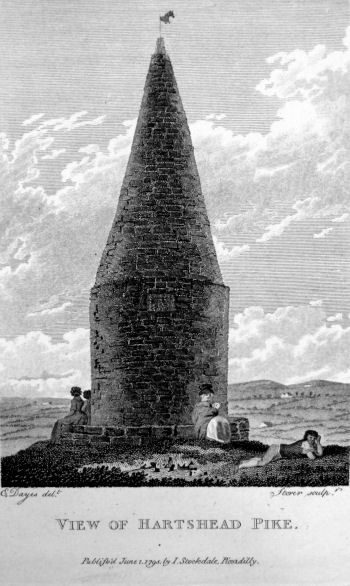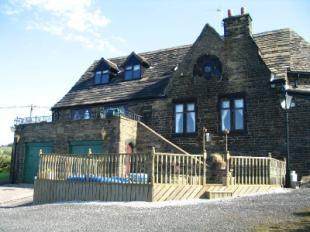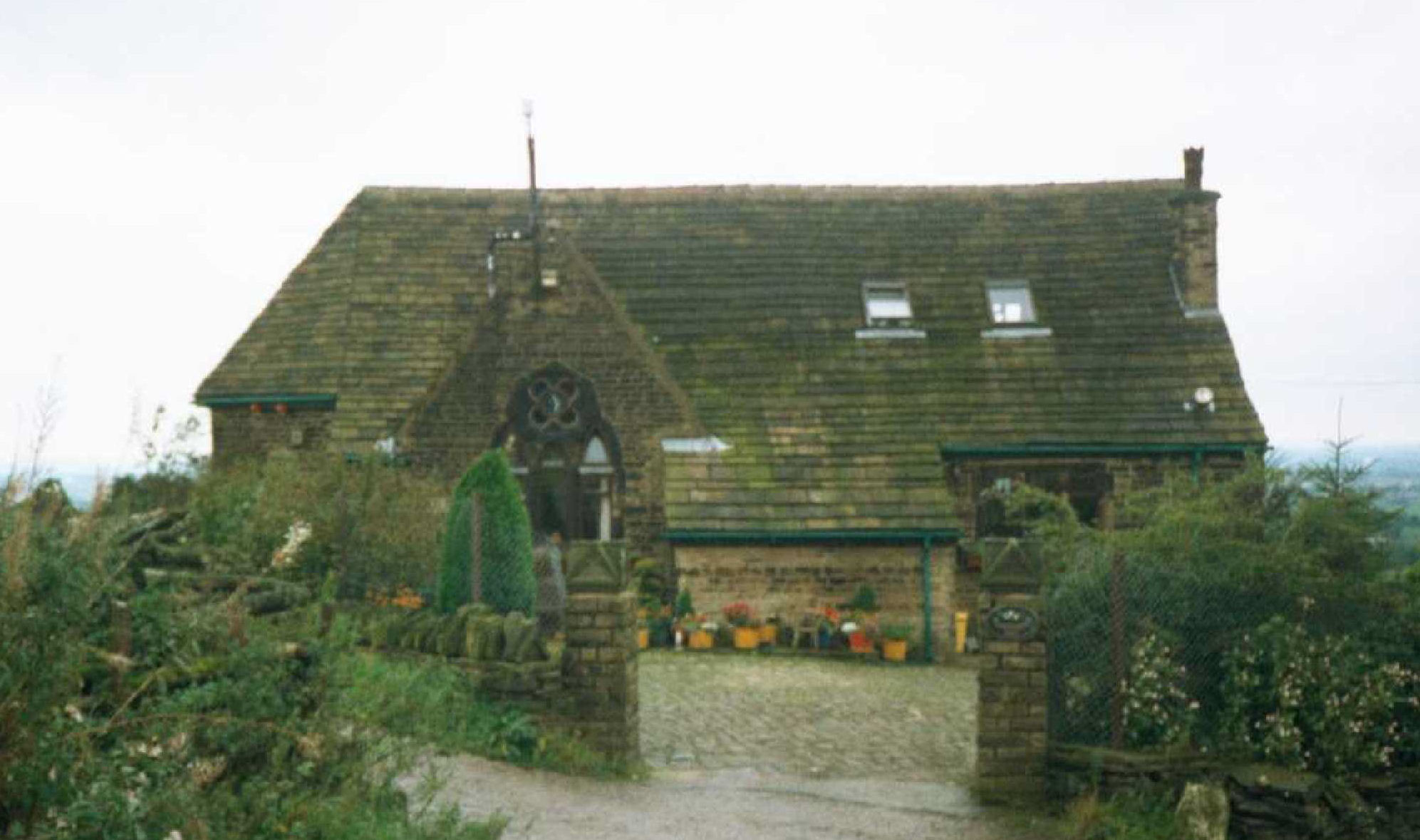
The Marland Family
Marland places: Hartshead
Marlands were living in Hartshead, on the moors bordering Yorkshire, from at least the early seventeenth century
 From
Dr
J.
Aiken
MD,
Forty
Miles
around
Manchester",
1795: From
Dr
J.
Aiken
MD,
Forty
Miles
around
Manchester",
1795:
Near [Mossley] stands Hartshead Pike, a favourite and well known object for the surrounding country, which is seen at a considerable distance, and in general has been supposed to be a sea mark. It is situated on very high ground betwixt Oldham and Mossley, from whence the traveller has a most delightful view of the surrounding country. We have ascertained, from very good authority, that it was formerly used as a beacon, and there are others in the area to answer it. It was rebuilt of solid stone in 1758, and is of considerable height and circumference. It is now split from top to bottom near half a yard in width. A few pounds laid out in repairs, if done in time, might preserve this pile for a century to come. On the top are the small remains of a weather cock, probably a hart's-head. |
|
|
 From Mossley and Saddleworth Reporter 1st May 1953:
The miniature church at Hartshead.
With its ten pews - five on each side of a central aisle - its two choir stall, small alter reading desk and tiny vestry, St Augustine's Church, Hartshead, has been re-decorated by parishioners. Said to be the smallest church in the Manchester area, it is one of the very few in the country that has never seen either a wedding or a funeral in its long history. For the past months men from the six families at Hartshead who still use the church have been engaged on giving it its first clean up for 20 years. Working in their spare time, mostly in the evenings, they have painted it in attractive green, pink and brown shades. Although none are professional painters the lettering is perfect and the whole work has an expert touch.
139 years old
George III was on the throne and Napoleon made his first abdication in the year the year the church at Hartshead was established and during the reign of nine monarchs it has stood on the outposts - Ashton and Mossley. The oldest document in connection with the church is a hymn sheet for services in June 1819 when the preacher was Rev. J. FIELDING of Littlemore.
By whom the Church was established and to what denomination, if any, it originally belonged is not known but it might reasonably be assumed that in 1823 it definitely came under the wing of the Church of England, as a branch of Mossley Parish Church of St George's. The fact that the centenary services were held in 1923 strengthens the belief that Hartshead Church became attached to the established church in 1923.
Started in workshop
Little appears to be known of the original building in which the church started, but it is believed that it was one of many handloom weaving workshops which were prevalent in the Mossley district in those days. Hartshead in the eighteenth century was a more important place than Mossley. Prior to the building of the present church in 1866 a day school was held at The Green, a house in close proximity to the Church. The headmaster was Mr Philip FIELDING. The day school was afterwards held in the church building.
Hartshead in those days with its colliery was a more prosperous place than today. The Broadcarr Colliery opened in 1843 functioned for many years and coal was carried in panniers by donkeys to the surrounding districts.
Family associations.
One of the founders of Hartshead Church was Mr Lees HYDE, and it is noteworthy that the HYDE family have retained their association with the church ever since. The original Mr Lees HYDE resided at Hartshead Farm. The MARLAND family of Ashton have also had a long association with the church.
The
foundation
stone
of
the
present
building
was
laid
by
the
Rev.
F.
A.
JONES,
vicar
of
St
George's
Church,
Mossley
from
1864
to
1872.
He
succeeded
the
Rev.
John
HEXALL
who
was
vicar
from
1831
to
1864.
St
Augustine's
has
always
been
self-supporting
and
raise
money
every
year
for
their
parish
church.
Representatives
from
the
church
always
walk
in
the
St
George's
procession
on
Whit-Friday
in
Mossley.
With
the
closing
of
the
colliery
and
the
removal
of
the
industry
from
Hartshead
the
congregation
of
St
Augustine's
has
declined.
Much
property
which
stood
in
proximity
to
the
church
has
been
demolished
and
the
people
have
gone
to
live
elsewhere.
Regular
services
are
however
held
and
Christenings
still
take
place.
The
church
has
gone
through
difficult
times
but
has
come
through
with
flying
colours,
and
is
still
very
much
alive.
Hartshead
has
now
been
absorbed
by
Ashton
and
it
is
in
this
direction
that
building
development
will
probably
take
place.
A
few
years
from
now
the
little
changed
church
of
St
Augustine's
may
be
the
centre
of a
much
larger
population.
But it was not to be; the Church was converted in to a private residence in 1989 and renamed Hartshead Hall, The property was recently (2007) on the market through Bridgfords Countrywide, who stated it was built around 1886 and was a Grade II listed building. |
| Webmaster: Andrew Gray |
Edited: 18 December 2015 |
 Established
in
1814,
in
the
year
of
the
great
frost,
when
a
six
weeks
fair
was
held
on
the
frozen
Thames.
St
Augustine's
Church
is
pleasantly
situated
on
the
western
slopes
of
Hartshead
Pike
and
commands
delightful
view
of
miles
of
country.
Established
in
1814,
in
the
year
of
the
great
frost,
when
a
six
weeks
fair
was
held
on
the
frozen
Thames.
St
Augustine's
Church
is
pleasantly
situated
on
the
western
slopes
of
Hartshead
Pike
and
commands
delightful
view
of
miles
of
country.